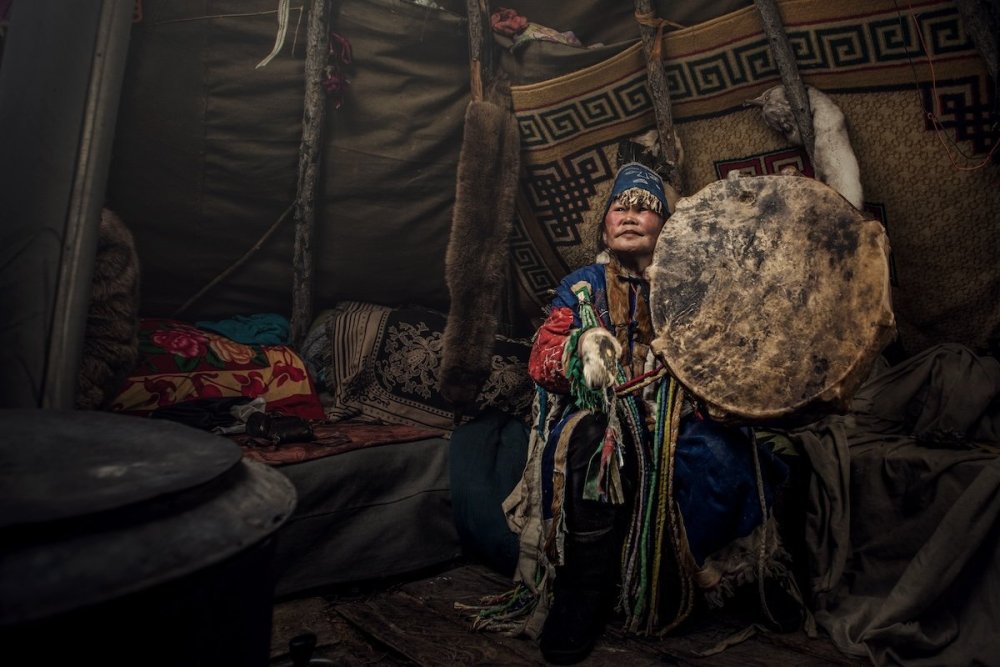Shamanism and shamanic healing has its roots in Indigenous communities, but its popularity is growing in the West. If you're curious about incorporating shamanic energy healing into your healthcare, Rhianna Quanstrom outlines what to expect.
Shamanic healing is one of the oldest healing modalities known to humanity. Shamanism is a spiritual technology, a way of life, and a method for addressing emotional, physical, mental, and spiritual challenges.
Traditionally, shamans play many key roles in Indigenous societies, both past and present. One of their main roles in the community is that of a healer. As such, there are specific techniques that shamans use for healing, which are quite different from Western allopathic medicine.
Today, shamanic healing techniques are becoming increasingly common in Western society. There are many trained shamanic practitioners available who use traditional healing methods with their clients.
MORE LIKE THIS:
- Psychedelic Integration: Honouring the Journey Beyond the Experience
- What is the Peyote Cactus and Is It Legal?
- Microdosing 101: A Modern Phenomenon Rooted in Ancient Times
Additionally, shamanic healing is not dependent on seeing a shamanic practitioner. As a meditation method, anyone can learn how to embark on a shamanic journey and receive direct healing from their own spirit guides.
In this blog, we’ll discuss what shamanic healing is, briefly explore the “shamanic journey,” and talk about what to expect from a shamanic healing session (and whether or not it’s right for you).
What is Shamanic Healing?
There are two main ways to experience shamanic healing: one is by seeing a shamanic practitioner, and the other is by going on your own shamanic healing journey through a guided or self-led meditation. So, what is a shaman and what does a shaman do exactly?

Drumming is used by shamanic practitioner to enter a trance
A shaman is an energy healer who works with the invisible, or “unseen,” realm to facilitate healing in the physical realm. When seeing a practitioner, they use shamanic energy healing techniques to address your imbalances and discomforts. It is a gentle and non-invasive modality.
Essentially, the shamanic practitioner goes into a trance state – usually by drumming, rattling, or singing – and “scans” your energy field. By scanning your field, they may pick up on imbalances such as stagnant or harmful energy or deep emotional wounds. During this process, the shaman communicates with their spirit guides, who inform them of what is most important to address with the client.
“Shamanic healing is one of the oldest healing modalities known to humanity. Shamanism is a spiritual technology, a way of life, and a method for addressing emotional, physical, mental, and spiritual challenges.”
Shamanic energy healing, therefore, simply requires you to relax and be open to the process. The shaman does the work of extracting harmful energy or sending healing energy to your wounds. They may also perform a soul retrieval, invite your power back, or welcome in your power animal to guide you.
The Shamanic Journey
Along with seeing a practitioner, you can experience shamanic energy healing within yourself by going on a meditative shamanic journey. This journey can be guided by a shaman, or you can learn the technique through a book or workshop and perform it yourself.
Sandra Ingerman, a licensed psychotherapist and shamanic practitioner, describes the shamanic journey in her book,Walking in Light: “One of the major ceremonies that a shaman performs is the shamanic journey. Performing a shamanic journey is how we can use the ancient art of shamanism for practical and visionary purposes in our daily life. It is a way to meet up with helping spirits in the invisible realms to access information and gain insights on how you can improve your life or to ask for healing help”.

During shamanic energy healing, a practitioner connects with spirit guides
Before starting the shamanic journey, you set an intention. In this case, it could be to receive healing from a spirit guide. To begin, you enter a trance state through drumming, ratting, dancing, or singing. Then, you travel to “another realm” through your conscious imagination. These realms are traditionally designated as the Upper, Middle, and Lower Worlds.
In one of these realms, you meet one or more helping spirits. These can come in the form of animals, plants, mythical creatures, dieties, your ancestors, or humans. Once you meet your helping spirit, you can ask them for healing. They may offer advice, reveal what needs to change in your life, or perform a healing ceremony for you.
During the shamanic journey, you are not necessarily “controlling” what you see. In other words, you let the vision come to you, without force, and allow curiosity to guide you.
How Does Shamanic Healing Differ From Other Energy Healing Techniques?
Shamanic energy healing is generally more complex and varied than other techniques. Modalities like Reiki or chakra healing do not involve the practitioner entering the spirit realm to commune with helping spirits. That aspect is unique to shamanism.
Shamanic healing sessions can vary widely. Because the shaman communicates with their spirit guides – or the client’s spirit guides or ancestors – they may receive highly specific information about what healing is most needed. Then, the shaman performs the healing or shares the messages they received.
With Reiki, for example, the practitioner channels universal life force energy into their client’s body. While this healing is powerful and can offer insights, it's different from the experimental and visionary nature of shamanic healing.
Shamanic Healing: What to Expect
If you go to a shamanic practitioner for healing, it’s common to fill out a form with basic information about yourself and what you wish to address. Then, you most likely will lay on a comfortable table in a private room where you’re invited to close your eyes and relax.
The shamanic practitioner may play a drumming track or drum/rattle themselves to enter a trance state. They might also play relaxing music to help you settle into a peaceful, meditative state.
“Shamanic energy healing requires you to relax and be open to the process. The shaman does the work of extracting harmful energy or sending healing energy to your wounds.”
The shaman will then perform their healing or guide you into a journey if that most serves. At the end, there will be time for discussion, where the shaman shares what they saw and relay any messages that you are meant to hear. Every shamanic practitioner has their own unique approach, but this a general outline of what you can expect.
If you decide to go on your own shamanic journey to receive healing, the best advice is to have no expectations. Hold your intention close while letting go and surrendering to the journey. Be sure to ground yourself afterward by spending time in nature, eating nourishing food, and reflecting on your experience.
Is Shamanic Healing Right For Me?
If you're open to healing on a spiritual level – and you wish to connect with your spirit guides and the healing wisdom of nature – shamanism may be right for you.
However, it’s important to know that shamanic healing is not a “quick fix.” It likely won’t immediately take away your pain or “cure” any condition. You may experience these results over a period of time with consistency and integration. Instant healings do happen, but they are rare. 
Traditional Mongolian shaman
Along that note, shamanic energy healing should not replace conventional medical care. It's a complementary healing method that can greatly support one’s healing journey. Indeed, shamanic healing has the potential to benefit anyone due to how personalized it is to each person’s experience.
How Can I Find a Shamanic Healer?
To find a shamanic healer in your area, start by researching alternative medicine practitioners. If there’s a local wellness centre that offers holistic treatments, check their website or call to see if they offer shamanic healing sessions.
“Shamanism is a powerful healing modality that connects you directly with your spirit guides and facilitates deep transformation.”
If you find a shamanic practitioner near you, it’s important to research them thoroughly. Read about them and their reviews, and check in with your intuition before seeing them. You want to meet with someone who is genuine and trustworthy.
Takeaway: Shamanic Healing
Shamanism is a powerful healing modality that connects you directly with your spirit guides and facilitates deep transformation. It can be a personal practice that one integrates into their everyday life, or it can be a healing session with a trained shamanic practitioner.
Whatever form of shamanic energy healing you decide to explore – whether with a practitioner or on your own – you’re likely to receive revelations, insights, and clarity on your healing journey.
Most importantly, shamanism is about connecting to your inner wisdom and light. In this way, it's a personal spiritual practice that can bring greater peace, clarity, and fulfilment to one’s life. ●
Images: shutterstock/CW Pix, shutterstock/Jozef Klopacka, shutterstock/Zolotarevs
happiness.com | The fine art of being: learn, practise, share
Are you a happiness.com member yet? Sign up for free to:
■ enjoy our happiness magazine with practical life tips
■ share and support in our happiness forum
Written by Rhianna Quanstrom
 Rhianna Quanstrom is a freelance writer, herbalist, and spiritual seeker with a passion for nature-based healing and sacred wisdom. Her writing draws from years of experience with meditation, shamanic practices, plant medicine, dream work, and the reclamation of the Sacred Feminine. Discover more of her writing and poetry on her Mystic Love Substack.
Rhianna Quanstrom is a freelance writer, herbalist, and spiritual seeker with a passion for nature-based healing and sacred wisdom. Her writing draws from years of experience with meditation, shamanic practices, plant medicine, dream work, and the reclamation of the Sacred Feminine. Discover more of her writing and poetry on her Mystic Love Substack.




Join the conversation
You are posting as a guest. If you have an account, sign in now to post with your account.
There are no comments to display.